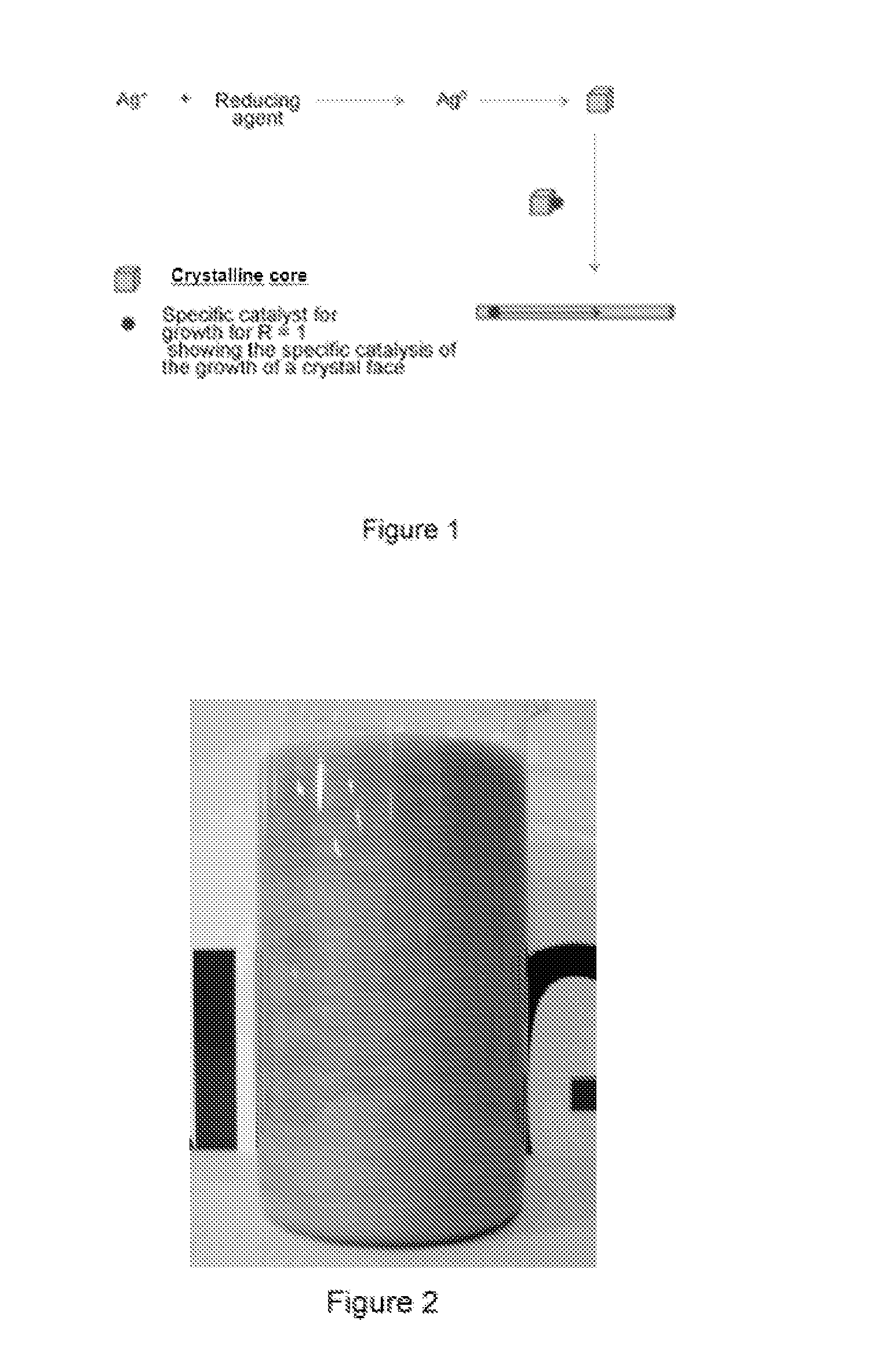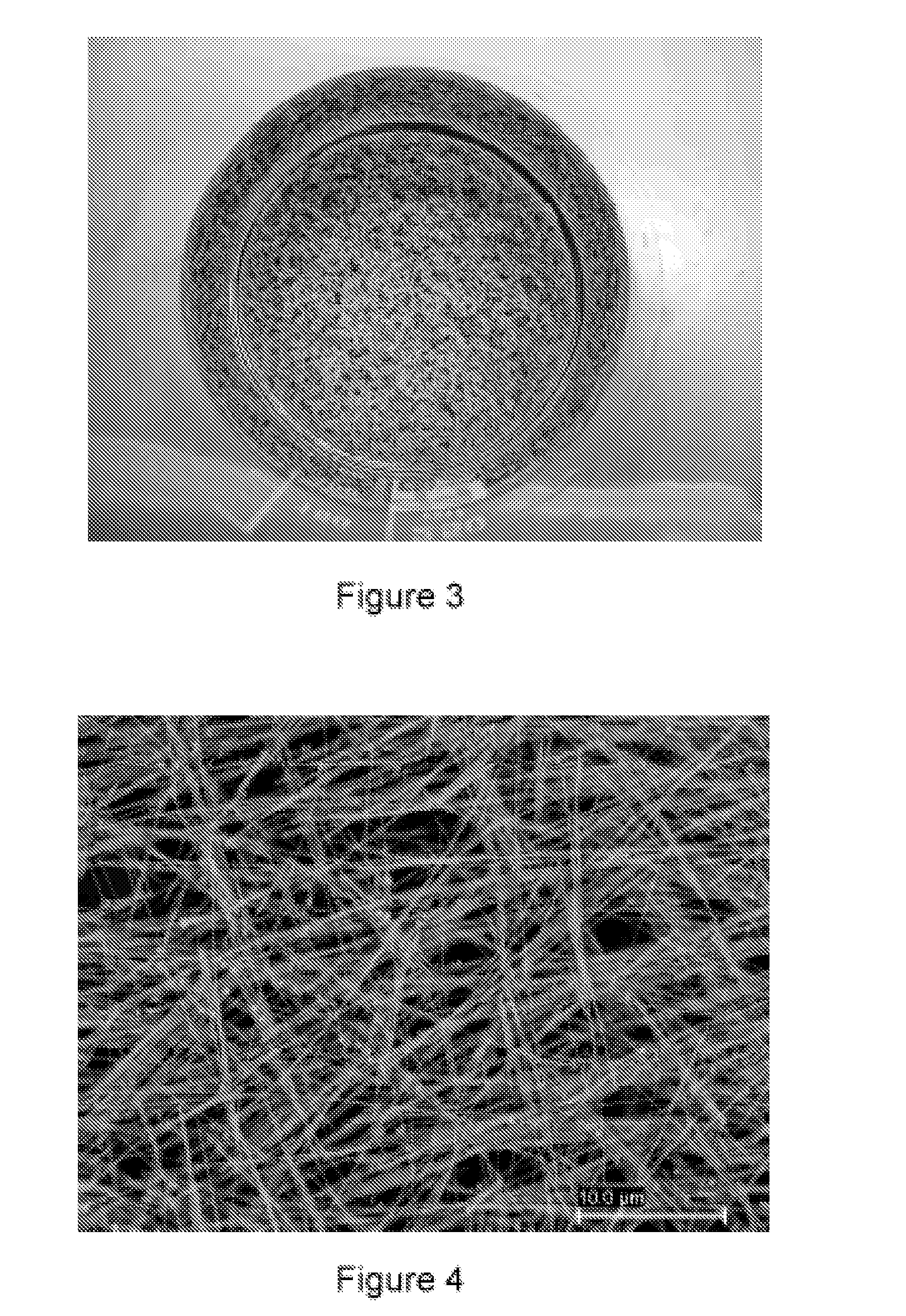Process for preparing anisotropic metal nanoparticles
a metal nanoparticle and anisotropic technology, applied in the field of anisotropic metal nanoparticle preparation, can solve the problems of difficult scaling and production of anisotropic nanoparticles in a simple and controlled manner, use of poorly defined and therefore poorly scalable processes, and method suffers from the drawbacks of using pressurized reactors. , to achieve the effect of reducing the number of nanoparticles, and reducing the number of nano-
- Summary
- Abstract
- Description
- Claims
- Application Information
AI Technical Summary
Benefits of technology
Problems solved by technology
Method used
Image
Examples
example 1
Synthesis of Ag Nanofibers with an Aspect Ratio (r) Equal to Approximately 500 and a Concentration Ratio R Equal to Approximately 1
[0062]1 L of water at 25° C. is introduced into a 10 L glass container with mechanical stirring. 30 mL of an Ag cluster solution, of Ag AQCs of between 2 to 5 atoms, Ag2—Ag5, with a concentration 10 mg / L are then added. 3.5 g of ascorbic acid are subsequently introduced under stirring and after 5 minutes 4 L of water are added. Finally, 3.4 g of silver nitrate are added under strong stirring. The reaction is constantly stirred for 4 hours. The Ag nanofibers are obtained as a precipitate which is dispersed again by stirring. The approximate percentage of fibers with respect to the total nanoparticles can be determined from the figures of the Scaning Electron Microscopy (see FIG. 5), this percentage being greater than 98% by weight. The overall yield of the reaction is about 100%.
The aspect ratio (r) is calculated from the relation length / diameter, 50·10−6...
example 2
Synthesis of Au Nanotriangles with a Concentration Ratio R Equal to Approximately 2
[0063]1 L of water at 25° C. is introduced into a 10 L glass container with mechanical stirring. 15 mL of an Ag cluster solution, of Ag AQCs of between 2 to 5 atoms, Ag2—Ag5, with a concentration 10 mg / L are then added. 2 g of ascorbic acid are subsequently introduced under stirring and after 5 minutes 4 L of water are added. Finally, 1 g of HAuCl4.3H2O is added under strong stirring. The reaction is constantly stirred for 1 hour. The Au nanoparticles are obtained as a precipitate which is dispersed again by stirring. It can be observed that the catalysis with Ag clusters, in a synthesis with R equal to approximately 2, compared to Example 1 with values of R equal to approximately 1, leads to the almost exclusively formation of triangular nanoparticles. The approximate percentage of nanotriangles with respect to the total nanoparticles can be determined from the figure of the Scanning Electron Microsc...
example 3
Synthesis of Au Nanostars with a Concentration Ratio R Equal to Approximately 3.2
[0064]1 L of water at 25° C. is introduced into a 10 L glass container with mechanical stirring. 25 mL of an Ag cluster solution, of Ag AQCs of between 2 to 5 atoms, Ag2—Ag5, with a concentration 10 mg / L are then added. 2 g of ascorbic acid are subsequently introduced under stirring and after 5 minutes 4 L of water are added. Finally, 1 g of HAuCl4.3H2O is added under strong stirring. The reaction is constantly stirred for 1 hour. The Au nanoparticles are obtained as a precipitate which is dispersed again by stirring. It can be observed that the catalysis with Ag clusters, in a synthesis with R equal to approximately 3.2, compared to Examples 1 and 2 with values of R equal to approximately 1 and 2 respectively, leads to the almost exclusively formation of star shape nanoparticles. The approximate percentage of nanostars with respect to the total nanoparticles can be determined from the figures of the Sc...
PUM
| Property | Measurement | Unit |
|---|---|---|
| size | aaaaa | aaaaa |
| diameter | aaaaa | aaaaa |
| diameter | aaaaa | aaaaa |
Abstract
Description
Claims
Application Information
 Login to View More
Login to View More - R&D
- Intellectual Property
- Life Sciences
- Materials
- Tech Scout
- Unparalleled Data Quality
- Higher Quality Content
- 60% Fewer Hallucinations
Browse by: Latest US Patents, China's latest patents, Technical Efficacy Thesaurus, Application Domain, Technology Topic, Popular Technical Reports.
© 2025 PatSnap. All rights reserved.Legal|Privacy policy|Modern Slavery Act Transparency Statement|Sitemap|About US| Contact US: help@patsnap.com



